Path Loss Models for Low-Power Wide-Area Networks: Experimental Results using LoRa
Conference: Mobilkommunikation – Technologien und Anwendungen - 23. ITG-Fachtagung
05/16/2018 - 05/17/2018 at Osnabrück, Deutschland
Proceedings: Mobilkommunikation – Technologien und Anwendungen
Pages: 5Language: englishTyp: PDF
Personal VDE Members are entitled to a 10% discount on this title
Authors:
Linka, Hendrik; Rademacher, Michael; Jonas, Karl (Hochschule Bonn Rhein-Sieg, Sankt Augustin, Germany)
Aliu, Osianoh Glenn (Fraunhofer FIT, Sankt Augustin, Germany)
Abstract:
More and more low-power wide-area networks (LPWANs) are being deployed and planning the gateway locations plays a significant role for the network range, performance and profitability. We choose LoRa as one LPWAN technology and evaluated the accuracy of the Received Signal Strength Indication (RSSI) of different chipsets in a laboratory environment. The results show the chipsets report significantly different RSSI. To estimate the range of a LPWAN beforehand, path loss models have been proposed. Compared to previous work, we evaluated the Longley-Rice Irregular Terrain Model which makes use of real-world elevation data to predict the path loss. To verify the results of that prediction, an extensive measurements campaign in a semi-urban area in Germany has been conducted. The results show that terrain data can increase the prediction accuracy.


